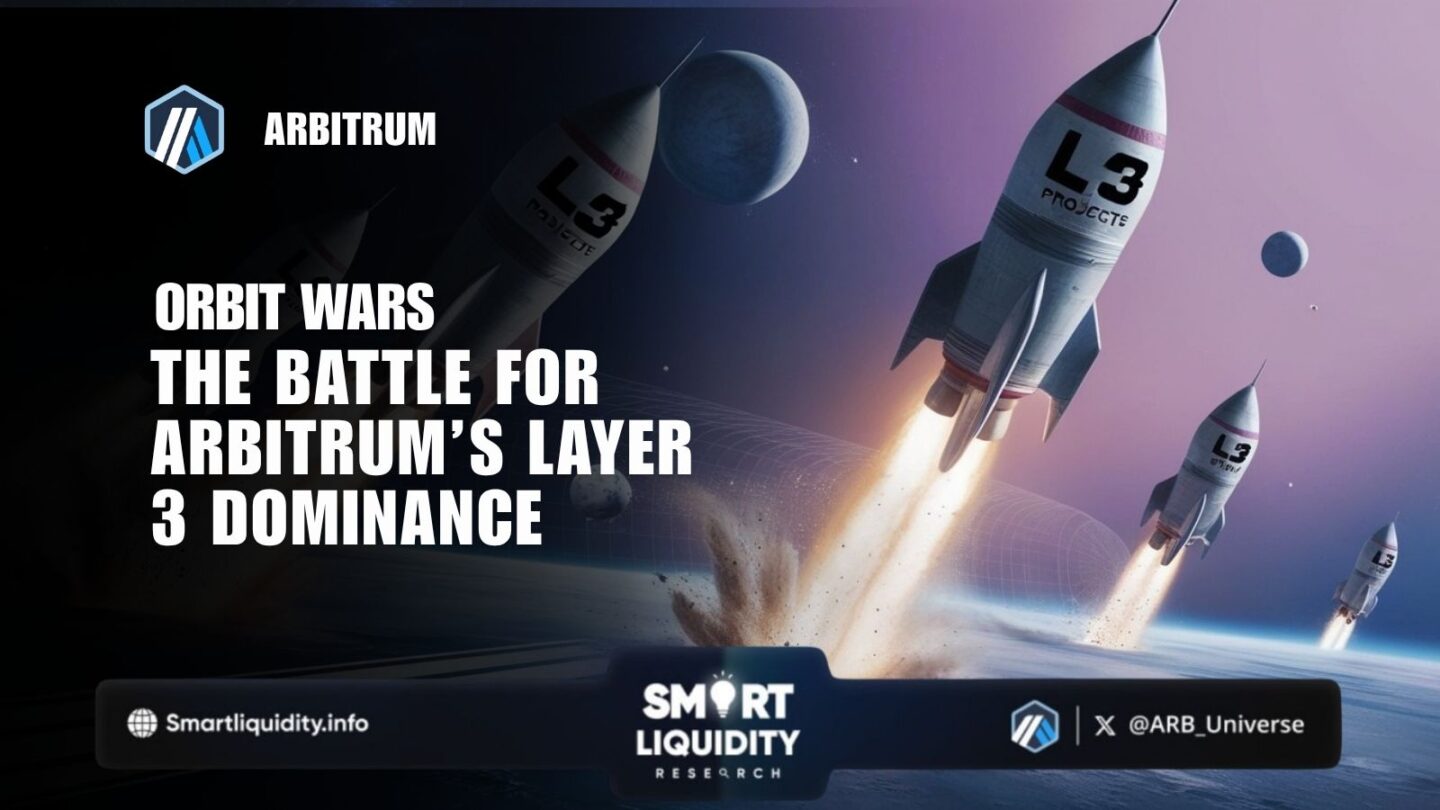Orbit Wars: The Battle for Arbitrum’s L3 Dominance


Orbit Wars: The Battle for Arbitrum’s L3 Dominance! The Web3 layers-of-layer landscape just got a fresh battleground: we’re entering the L3 arena, and Arbitrum is playing for high stakes.
This article digs into how Arbitrum’s L3 strategy is unfolding, who’s building on it, and why this matters for DeFi yield-farmers and on-chain traders.
1. Why L3? Why Now?
From L1 to L2 to L3
- At the foundation, we have Ethereum (L1).
- On top of that, Arbitrum (and peers) operate L2 rollups like Arbitrum One.
- Now, developers are deploying Layer-3 (L3) chains on top of L2, to serve highly-specialised use-cases (gaming, social, micro-transactions, DeFi) with ultra-low fees, high throughput, and custom gas/contract logic.
Why now?
A few reasons:
- L2 congestion, gas costs, and generalized chains leave performance headroom. L3 gives you a dedicated chain for a specific application.
- With the announcement of Arbitrum Orbit (the framework for permissionlessly launching L3s), the tooling is ready.
- The economics: each L3 can capture its niche, while still settling (and leveraging security) on Arbitrum’s L2 infrastructure.
- For traders & yield-farmers: dedicated L3 chains mean lower fees, faster settlements, possibly customised tokenomics.
What does “dominance” look like?
We’re looking for Arbitrum to:
- Become the preferred base for app-specific chains (L3) → thus locking in activity, liquidity, and developer mind-share.
- Capture large TVL, gas-fee revenue, and ecosystem growth through Orbit chains.
- Ward off competing stacks (e.g., other L2s or L3 frameworks) that might lure away projects & liquidity.
2. Arbitrum’s L3 Playbook
Arbitrum Orbit: The launchpad
Arbitrum introduced the Orbit stack: a permissionless framework to spin up L3 chains that settle to Arbitrum’s L2s.
Key features:
- Developers can customise gas tokens, governance, contract languages (via Stylus: Rust/C++/Solidity) on the L3
- Data availability and execution models that aim for sub-cent fees and high throughput.
- The ecosystem has launched a growing number of Orbit chains: as of Sept 2025, 85+ Orbit chains are settling on Arbitrum One.
Ecosystem moves and incentive alignment
- The Arbitrum Foundation launched an Expansion Program and Developer Guild to encourage projects to build L3s.
- Revenue dashboards show transparency of Orbit chains’ fee-flows, signalling the ecosystem wants data and accountability.
- A proposal even urged distributing ARB tokens to L3 users/builders to stimulate growth.
Strategic advantage: App-Chains on Steroids
Because each Orbit chain can be tailored for specific use cases (gaming, social, DeFi), Arbitrum is trying to position itself as the backbone of app-specific L3s — not just a generic L2. That’s how dominance is claimed: by being the default platform for niche verticals.
Strategic advantage: App-Chains on Steroids
Because each Orbit chain can be tailored for specific use cases (gaming, social, DeFi), Arbitrum is trying to position itself as the backbone of app-specific L3s — not just a generic L2. That’s how dominance is claimed: by being the default platform for niche verticals.
3. Key L3 Projects to Watch
Below are some of the most interesting apps/chains leveraging Arbitrum’s L3 strategy.
Xai Network
An L3 built for gaming on Arbitrum Orbit.
- Aims to handle large-scale game transactions, in-game economies, and asset ownership with low friction.
- Represents the “gaming vertical” of the L3 push — if games migrate, wallets open, assets move fluidly, it drives volume.
Sanko (Chain for games/NFTs)
Another Orbit-based L3 with focus on games + NFTs.
- Built via Caldera (rollup-as-a-service) settling to Arbitrum One.
- Native token DMT; example of a dedicated L3 with its own economy.
Superposition
A DeFi-centric L3 on Arbitrum One using Orbit + Stylus.
- First DApp: Longtail (an AMM model).
- Demonstrates that it’s not just games — DeFi apps are also leveraging L3 for performance and custom logic.
Polychain Monsters L3
NFT-game ecosystem launching its own L3 via Arbitrum Orbit and AltLayer.
- Highlights how existing game ecosystems are migrating to a dedicated L3 to capture user experience/scale.
Other high-level mentions
- There are 18+ disclosed Orbit-based projects in the pipeline spanning gaming, social, and DeFi.
- Use cases: social networks, IoT, micro-transactions (L3 is being pitched as the era of “scale and specialisation”).
4. The Wars: Competitive Landscape & Risks
Who’s competing?
- Other chains/frameworks, e.g., OP Stack (Optimism), zkStack (zkSync), are not idle. L3s will be built elsewhere, too.
- Non-Orbit L3s might capture verticals (e.g., social, gaming) before Arbitrum fully consolidates them.
- Liquidity fragmentation: With many L3s, the network effect may dilute unless Arbitrum stays tightly integrated and builders stay loyal.
Key risk vectors
- Tokenomics & revenue capture: If individual L3 chains siphon volume but don’t benefit the Arbitrum ecosystem (or ARB holders), the alignment might break.
- Security & trust: L3s are further down the stack; settlement still matters. If an L3 underperforms (e.g., bad bridge, downtime), it may reduce trust in the Orbit model.
- User experience & adoption: For yield-farmers/traders like you, it matters whether bridging to and interacting with L3 is frictionless, cross-chain is seamless, and liquidity is plentiful.
- Governance & centralisation: Some empirical findings show sequencer / express-lane centralisation risks for Arbitrum.
- Game-theoretic contest: Other ecosystems may innovate faster. If a game or DeFi hub chooses another L3/stack, the “dominance” narrative could shift.
5. What This Means for Yield-Farmers & On-Chain Traders
Because your channel revolves around “AI Lifehacks & Automation for Daily Living” and you want to engage yield-farmers and on-chain traders, here are some angles and opportunities:
- Low-fee niche chains: L3s like Superposition offer near-zero fees and custom AMMs — ideal for high-frequency or micro-strategy trading.
- App-specific liquidity pockets: Rather than fighting for share on a big generic chain, moving into a dedicated L3 could give early mover advantage (e.g., a new game economy, or a DeFi vault).
- Bridge & tool-automation opportunities: You can create scripts or bots that monitor liquidity flows or fee generation on Orbit chains (85+ chains earning revenue already)
- Tokenomics interplay: Projects launching on L3 may reward early users (airdrops, liquidity incentives) because they need traction. E.g., bridging to Superposition testnet to earn points.
- Ecosystem capture & arbitrage: Because each L3 is specialised, there may be arbitrage opportunities between L3 ↔ L2 ↔ L1 or across parallel L3s (especially if one chain lacks liquidity).
6. The Verdict: Who Wins the Orbit Wars?
The battle is only just beginning. Here’s how I see the probabilities:
- Short-term (next 12-18 months): Arbitrum is well-positioned. With Orbit live, many projects are already deploying, and the ecosystem momentum is on their side.
- Mid-term (2-3 years): The winner will be whoever captures the most volume, deepest liquidity, strongest dev-ecosystem, and aligns incentives so that the underlying chain (Arbitrum + ARB token) benefits meaningfully from L3 activity.
- Long-term (beyond): It may not be just one winner — we could see multiple “dominant” L3 hubs, but the one that becomes the go-to builder platform for app-chains (gaming + DeFi + social) will have a durable lead.
7. Actionable Signals to Watch
- Monitor the revenue dashboard for Orbit-chains (e.g., batch fees, daily chain revenue) — publicly available data.
- Watch for L3 token launches / bridging incentives (like Superposition) — early incentives = early entry.
- Track which major games or DeFi hubs migrate to Orbit L3s; that can attract users, assets, and volume.
- Check interoperability: how easy it is to move assets between L3 ↔ L2 ↔ L1 and cross-L3. Bottlenecks reduce upside.
- Identify liquidity fragmentation risks: too many small L3s, each with low liquidity, may lower returns. The winner will consolidate.
- Follow governance & tokenomics: how much of the “value capture” flows back to the Arbitrum ecosystem / ARB holders vs being isolated in each L3.
Final Word
The “Orbit Wars” are underway — the duel for L3 dominance on the Arbitrum stack is not sci-fi hype, it’s happening now. For yield-farmers and on-chain traders who monitor new chains, bridges, arbitrage, and developer flows: L3s may offer some of the lowest-hanging fruits for automation, trading edge, and early mover advantage. Arbitrum holds the strategic pass; now it’s down to builders, liquidity, and users to decide if it holds the fortress.




